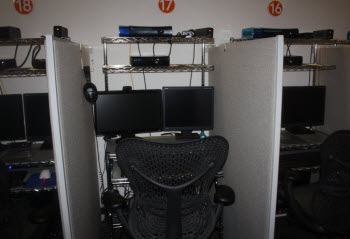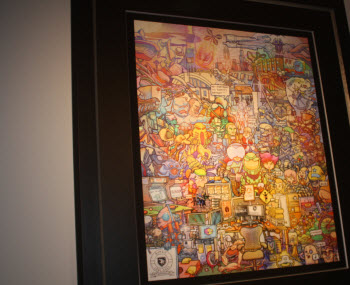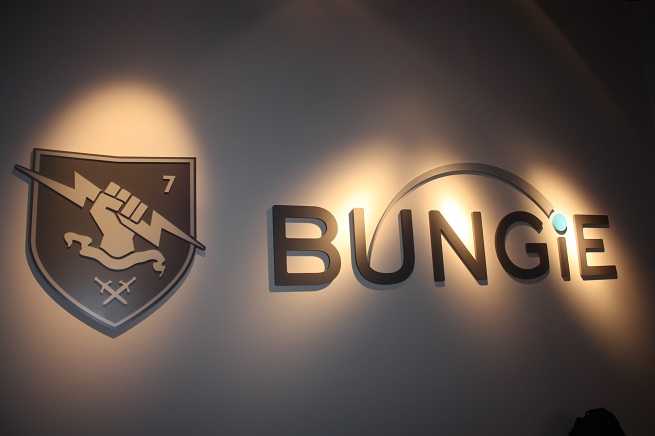Little by little, Bungie is opening up. The company has had to keep a lot of secrets, especially since it split from Microsoft in 2009 and began working on a top-secret project. We now know that the secret, code-named Tiger, is a new game series called Destiny.
 A visit to Bungie’s headquarters is an enviable journey. It’s like going to Oz and seeing the man behind the curtain. Gamers and budding developers would love to get a foot in the door — and perhaps make off with a souvenir. But having been there, I can tell you it’s pretty secure place. Fans have to keep out, but the whole place seems like it is built in the service of fans, like a physical homage to Halo and the company’s next big project.
A visit to Bungie’s headquarters is an enviable journey. It’s like going to Oz and seeing the man behind the curtain. Gamers and budding developers would love to get a foot in the door — and perhaps make off with a souvenir. But having been there, I can tell you it’s pretty secure place. Fans have to keep out, but the whole place seems like it is built in the service of fans, like a physical homage to Halo and the company’s next big project.
After a couple of leaks spilled the beans, Bungie acknowledged Destiny and said it would make a series of games over the next ten years, all to be published by Activision. For the first time since the Halo series started more than a decade ago, the new game series will be multi-platform, publishing on platforms such as the PlayStation 3 and PlayStation 4, not to mention the next Xbox and perhaps the PC.
We recently interviewed Pete Parsons, chief operating officer, about what it’s like to work at Bungie. Eric Osborne, community manager and writer at Bungie, led me on a tour through the company’s 80,000-square-feet headquarters in Bellevue, Wash., a suburb of Seattle. The place has no signs visible from the street, and you would never guess that it is housed inside a shopping mall in an office park. It used to be a theater complex and a bowling alley. This is the place where a team was willing to bet on the future and walk away from a multibillion-dollar game property.
A Halo museum, invaded by the Sexy Sax Man

The past is in the downstairs, where the former bowling alley was. Security is tight.
In fact, the day before I got there, two security officers had to escort a woman who was breaking the rules by trying to talk with every employee who exited the building. She wanted speakers for her class, and she also wanted to find out how her son could get work at Bungie. A few days earlier, a guy named Sexy Sax Man burst in to play music, and he got thrown out too.
Osborne says that the downstairs area is where they show fans who come into the building during shows such as Penny Arcade’s PAX event. During such times, dozens of fans mill about the entrance, hoping for a peek inside.
Just past the lobby, the downstairs hallway leads to a series of rooms: an arcade game room and interview rooms. In those interview rooms, a potential new hire could spend a whole day, being interviewed by one Bungie staffer after another. Bungie contends it has never lowered its standards for hiring. The hallway itself is littered with Halo paraphernalia on the walls and behind glass cases. Props from marketing campaigns of years past sit around.
A 3o-foot glass case houses a bunch of Halo toys and life-size replicas of weapons. Another glass case holds the trophies — all of the awards, like Halo’s first million games shipped. A big metallic award with a lightning bolt sits above a big couch. Nearby is a theater where Bungie entertained the gaggle of press that recently came to see Destiny. We were in there all alone, lucky to have our own private tour. The theater seems way too big for our small group. It has seating for 80.
 Further down the crooked hallway is the Laboratorium, where a bunch of cubicles are equipped with game machines, monitors, and webcams. The team shoots video of players as they play snippets of the upcoming game. They gauge the reactions and emotions of the players. The team can even do eye-tracking, or monitoring which part of the screen the player is looking at. If those players get lost in a maze, the team goes back to designing something better.
Further down the crooked hallway is the Laboratorium, where a bunch of cubicles are equipped with game machines, monitors, and webcams. The team shoots video of players as they play snippets of the upcoming game. They gauge the reactions and emotions of the players. The team can even do eye-tracking, or monitoring which part of the screen the player is looking at. If those players get lost in a maze, the team goes back to designing something better.
Still further down the crooked hallway is the Spandex Palace. This is the motion-capture studio, a big empty space with floor mats and rigs that mount 22 motion-capture cameras. The team can capture all movement in the room, including that of performance actors as they speak their lines. The cameras record the movements in 3D and store them in digital form.

Game artists can take the entire performance — the body movements, the lip movements, the voice acting — and bring it directly into the game. They can then enhance it with their digital artistry, so it looks nothing like actors in spandex and more like alien creatures and space marines. The fact that Bungie has its own mo-cap studio shows it is working on the high end; many other studios hire motion-capture experts to do the work for them.
One painting on the wall, by Seattle artist Ken Taya, stands out. Created for Bungie’s 20th anniversary, it has a bunch of events from the company’s history woven into a single, overcrowded painting. At the bottom is a chair, and by the chair is a tail. It is a tiger’s tail, and it was a hint about what was coming up.
There’s a snack room with all sorts of free goodies. Bungie employees get a lot of free food. And executives like Parsons go out to lunch with most new employees, so they can get a download on what works and what doesn’t.
“We have a free-lunch program so we can make sure new employees meet older employees,” Parsons said. “We even have something called Bungie University where there’s more than 60 hours worth of video. Starting from when we kicked off Destiny to the team at large in August 2009, you can watch all the way until now.”
There’s also something called Tiger University, which brings new employees up to speed on the new project.

